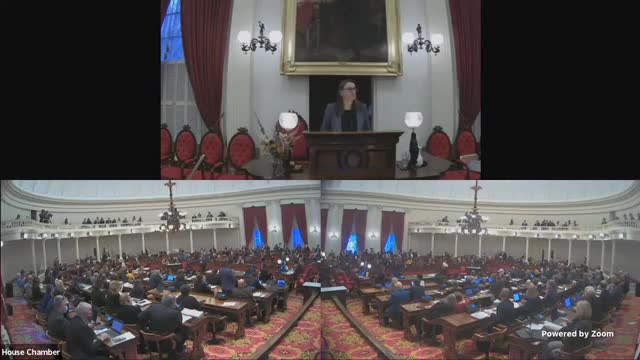Vermont lawmakers debate overdose prevention centers amid rising drug overdose crisis
January 10, 2024 | HOUSE OF REPRESENTATIVES, Committees, Legislative , Vermont

This article was created by AI summarizing key points discussed. AI makes mistakes, so for full details and context, please refer to the video of the full meeting. Please report any errors so we can fix them. Report an error »

In a pivotal session on January 10, 2024, the Vermont House of Representatives engaged in a heated debate over the proposed establishment of overdose prevention centers, commonly referred to as safe injection sites. The discussions highlighted the urgent need to address the state's escalating opioid crisis, with lawmakers weighing the potential benefits against legal and community concerns.
The session opened with inquiries about the stance of the Beaumont Commissioner of Health regarding safe injection sites. The commissioner acknowledged these centers as one strategy in combating the overdose crisis but emphasized the need for further research. Testimonies from health professionals, including a nurse practitioner from the Johnson Health Center, supported the implementation of overdose prevention centers as essential to a comprehensive approach to the crisis.
Opponents of the bill raised significant legal concerns, citing the federal crack house statute, which prohibits the use of facilities for drug-related activities. However, proponents argued that these centers primarily focus on providing medical aid and counseling, rather than facilitating drug use. A letter from Attorney General Charity Clark expressed conditional support for the concept, contingent on federal assurances against prosecution and the establishment of necessary support services.
The debate intensified as lawmakers discussed the operational guidelines for these centers, with some expressing skepticism about the lack of clarity on zoning and the specifics of how the centers would function. Critics voiced concerns that the bill could inadvertently enable drug use without adequately addressing the underlying issues of addiction treatment and recovery.
Supporters of the bill, however, passionately argued for its necessity, citing evidence from other states and countries where overdose prevention centers have successfully reduced overdose deaths and improved public health outcomes. They emphasized that these facilities could serve as critical access points for individuals struggling with addiction, providing not only a safe space to use drugs but also connections to treatment and recovery resources.
As the session progressed, the emotional weight of the crisis was palpable, with lawmakers sharing personal stories and statistics about the devastating impact of overdoses in Vermont. The urgency of the situation was underscored by the staggering number of overdose deaths in recent years, prompting many representatives to advocate for immediate action.
In conclusion, the Vermont House of Representatives faced a crucial decision on whether to move forward with the bill to establish overdose prevention centers. The outcome of this debate could significantly influence the state's approach to addressing the opioid epidemic, balancing the need for harm reduction with the complexities of legal and community concerns. As the session adjourned, the question remained: would Vermont take a bold step towards innovative solutions in the fight against addiction, or would it retreat into traditional methods that have proven insufficient?
The session opened with inquiries about the stance of the Beaumont Commissioner of Health regarding safe injection sites. The commissioner acknowledged these centers as one strategy in combating the overdose crisis but emphasized the need for further research. Testimonies from health professionals, including a nurse practitioner from the Johnson Health Center, supported the implementation of overdose prevention centers as essential to a comprehensive approach to the crisis.
Opponents of the bill raised significant legal concerns, citing the federal crack house statute, which prohibits the use of facilities for drug-related activities. However, proponents argued that these centers primarily focus on providing medical aid and counseling, rather than facilitating drug use. A letter from Attorney General Charity Clark expressed conditional support for the concept, contingent on federal assurances against prosecution and the establishment of necessary support services.
The debate intensified as lawmakers discussed the operational guidelines for these centers, with some expressing skepticism about the lack of clarity on zoning and the specifics of how the centers would function. Critics voiced concerns that the bill could inadvertently enable drug use without adequately addressing the underlying issues of addiction treatment and recovery.
Supporters of the bill, however, passionately argued for its necessity, citing evidence from other states and countries where overdose prevention centers have successfully reduced overdose deaths and improved public health outcomes. They emphasized that these facilities could serve as critical access points for individuals struggling with addiction, providing not only a safe space to use drugs but also connections to treatment and recovery resources.
As the session progressed, the emotional weight of the crisis was palpable, with lawmakers sharing personal stories and statistics about the devastating impact of overdoses in Vermont. The urgency of the situation was underscored by the staggering number of overdose deaths in recent years, prompting many representatives to advocate for immediate action.
In conclusion, the Vermont House of Representatives faced a crucial decision on whether to move forward with the bill to establish overdose prevention centers. The outcome of this debate could significantly influence the state's approach to addressing the opioid epidemic, balancing the need for harm reduction with the complexities of legal and community concerns. As the session adjourned, the question remained: would Vermont take a bold step towards innovative solutions in the fight against addiction, or would it retreat into traditional methods that have proven insufficient?
View full meeting
This article is based on a recent meeting—watch the full video and explore the complete transcript for deeper insights into the discussion.
View full meeting